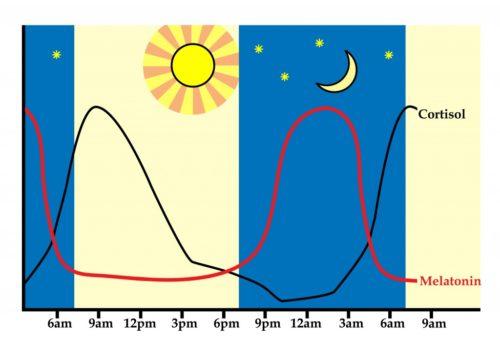Optimizing the Sleep-Wake Cycle
Getting your circadian rhythm into harmony will take discipline and a little work but totally achievable
What is the Sleep-Wake Cycle?
Insomnia, anxiety, and fatigue are the three most common conditions that I see in my practice. These symptoms can be caused such a wide array of things. Underlying it all is a disruption of the circadian rhythm, which controls the sleep-wake cycle.
In our concrete jungle with electric lights and heating and cooling systems, it is often difficult to remember that we are, indeed, deeply connected to our environment. We take signals from the environment and make the appropriate corresponding hormones. Many of our internal systems are dependent upon the environment. And we need tight regulation of these systems to optimize our health and performance.
One of the best examples of this environmental dependency is the circadian rhythm. The sleep-wake cycle is driven by the circadian clock at the center of the hypothalamus in the brain. The circadian rhythm is controlled by the ebb and flow of two main hormones, cortisol and melatonin, in direct response to our exposure to light and darkness.
Let’s Start With Cortisol
Cortisol peaks just before you wake up in the morning. I think of cortisol as the get up and go hormone. It gives us the oomph to get out of bed and start the day. Cortisol is also responsible for proper immune function, blood sugar balance, helping maintain healthy weight, providing energy for the body, and plays a role in the health of the cardiovascular system and the reproductive system.
The wide-ranging effect of cortisol helps us to understand why maintaining a healthy cortisol level is so essential to our health. Stress is one of the worst things for our health. When cortisol levels are too high, as in times of stress, it can lead to immune suppression, blood sugar disorders like diabetes, excessive weight gain, high blood pressure, and infertility.
Melatonin and Blue Light
Melatonin controls the timing of the sleep-wake cycle. It has been used to help with insomnia and jet lag because of its powerful regulation of sleep timing. There is also evidence that melatonin acts as an antioxidant and has some effect on the immune system.
Exposure to light and dark is the greatest driving force behind the cyclical nature of the release of cortisol and melatonin.
Being in the sunlight is the best way to ensure healthy melatonin levels at night. We have specialized light receptors in the eyes and skin that send the signal to your hypothalamus to regulate your melatonin levels.
Circadian rhythm regulation is equally dependent on protecting your eyes from that same daylight spectrum at night. Darkness at night sends a signal to your brain to amp up the production of melatonin. The blue light spectrum from sunlight suppresses melatonin production. Unfortunately, that same blue light is found in LED lights, and lights from computer, television, phone, and tablet screens. Most of us are in front of a screen all day and again before bed. And we proudly shine our energy efficient LED lights the moment the sun starts to set.
This constant exposure to blue light decreases our melatonin levels and increases our stress hormone, cortisol. This results in immune dysfunction, cardiovascular problems, blood sugar disorders, fatigue, depression, anxiety, and insomnia.
What Can We Do?
Circadian rhythm regulation is one of those essential components of a healthy lifestyle. Here’s how you do it:
- Go out into the sun, without sunglasses, for 15-60 minutes a day.
- Use a light therapy box at intervals during the day, or if you cannot get outside
- Keep your lights on dim at night, and switch a couple of bulbs out for red bulbs to use at night. The red spectrum stimulates melatonin production.
- Avoid screens at night
- If you use a computer at night, download f.lux, a program that changes the color temperature on your computer in accordance to the time. It turns more red and less blue as the sun sets
- If you use a screen at night, invest in some amber tinted glasses, which block the blue light
- Sleep in a dark room. You may think it is not affecting you, but light receptors in your skin and eyes are impacted even when your eyes are closed. Any light sensed by your eyes will signal the brain to halt production of melatonin, giving you less restful and restorative sleep. Invest in blackout blinds and cover all the little LED lights in your room (on your digital clock, TV, chargers, and smoke detectors). If you can see your hand in front of you, your room is not dark enough.
Learn about how sound can help aid your sleep process:
Why Walnuts Are A Good Snack To Eat Before Bed
The Right Noise – Pink, White ,Brown, Blue, Black, and Red Noise: Your Guide to a Good Night’s Sleep
How to Sleep Better: Your Guide for Good ZZZ
Everything You Need To Know About Magnesium And Sleep
Optimizing the Sleep-Wake Cycle
How to Reset Your Sleep Cycle When You Live With Insomnia
The Importance of Sleep with Alzheimer’s
What You Eat Affects How You Sleep
GABA & L-theanine mix Improves REM Sleep, Stabilizes mood and helps with depression
What Happens When Circadian Rhythm Is Off? Learn More
Do You Wake Up Every Night At The Same Time? Learn More
How to Reset Your Sleep Cycle When You Live With Insomnia Learn More
What You Eat Affects How You Sleep? Learn More
GABA / L-theanine mixture Improves REM Sleep, Antidepressant, and Mood-stabilizing Study Says Learn More

